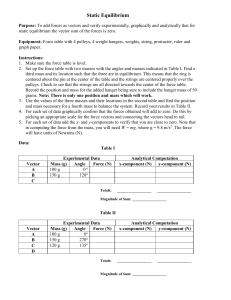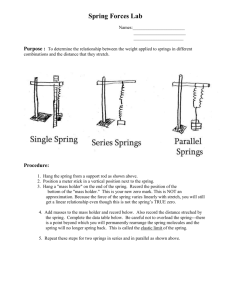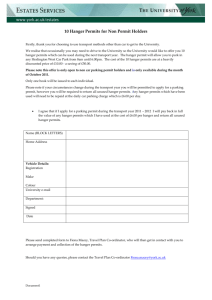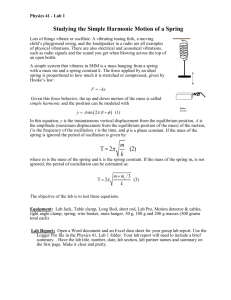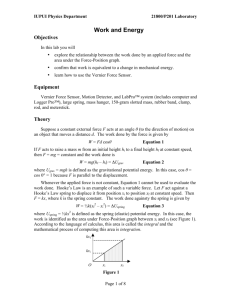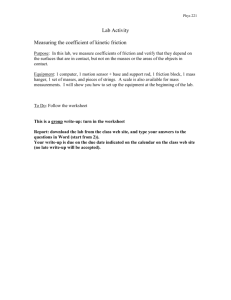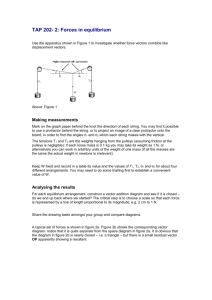ReadMeFirst,Experime.. - Worcester Polytechnic Institute
advertisement
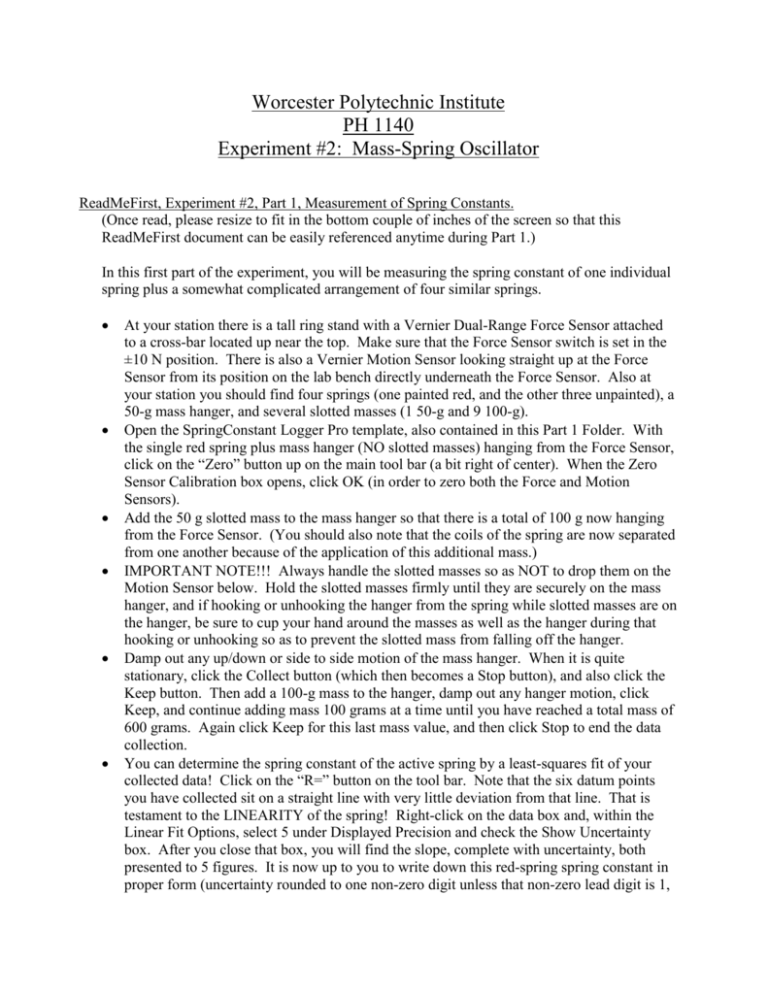
Worcester Polytechnic Institute PH 1140 Experiment #2: Mass-Spring Oscillator ReadMeFirst, Experiment #2, Part 1, Measurement of Spring Constants. (Once read, please resize to fit in the bottom couple of inches of the screen so that this ReadMeFirst document can be easily referenced anytime during Part 1.) In this first part of the experiment, you will be measuring the spring constant of one individual spring plus a somewhat complicated arrangement of four similar springs. At your station there is a tall ring stand with a Vernier Dual-Range Force Sensor attached to a cross-bar located up near the top. Make sure that the Force Sensor switch is set in the ±10 N position. There is also a Vernier Motion Sensor looking straight up at the Force Sensor from its position on the lab bench directly underneath the Force Sensor. Also at your station you should find four springs (one painted red, and the other three unpainted), a 50-g mass hanger, and several slotted masses (1 50-g and 9 100-g). Open the SpringConstant Logger Pro template, also contained in this Part 1 Folder. With the single red spring plus mass hanger (NO slotted masses) hanging from the Force Sensor, click on the “Zero” button up on the main tool bar (a bit right of center). When the Zero Sensor Calibration box opens, click OK (in order to zero both the Force and Motion Sensors). Add the 50 g slotted mass to the mass hanger so that there is a total of 100 g now hanging from the Force Sensor. (You should also note that the coils of the spring are now separated from one another because of the application of this additional mass.) IMPORTANT NOTE!!! Always handle the slotted masses so as NOT to drop them on the Motion Sensor below. Hold the slotted masses firmly until they are securely on the mass hanger, and if hooking or unhooking the hanger from the spring while slotted masses are on the hanger, be sure to cup your hand around the masses as well as the hanger during that hooking or unhooking so as to prevent the slotted mass from falling off the hanger. Damp out any up/down or side to side motion of the mass hanger. When it is quite stationary, click the Collect button (which then becomes a Stop button), and also click the Keep button. Then add a 100-g mass to the hanger, damp out any hanger motion, click Keep, and continue adding mass 100 grams at a time until you have reached a total mass of 600 grams. Again click Keep for this last mass value, and then click Stop to end the data collection. You can determine the spring constant of the active spring by a least-squares fit of your collected data! Click on the “R=” button on the tool bar. Note that the six datum points you have collected sit on a straight line with very little deviation from that line. That is testament to the LINEARITY of the spring! Right-click on the data box and, within the Linear Fit Options, select 5 under Displayed Precision and check the Show Uncertainty box. After you close that box, you will find the slope, complete with uncertainty, both presented to 5 figures. It is now up to you to write down this red-spring spring constant in proper form (uncertainty rounded to one non-zero digit unless that non-zero lead digit is 1, in which case you round to two digits; then round the spring constant to the same decimal place as the right-most digit of the uncertainty) on a sheet of scratch paper for future reference. Repeat all steps in this procedure for the other, somewhat complicated arrangement that your lab instructor will describe for you (a series, parallel arrangement of 4 similar springs, one of which will be the red spring), BUT with the following variation. Use the same Logger Pro template as before, but this time “Zero” the two sensors with the mass hanger PLUS 50 g hanging from the spring arrangement. Then after zeroing, begin measuring force versus extension with another 100-g mass added for a total hanging mass of 200 g. Then obtain four more datum points by adding masses in 200-g increments up to a total of 1000 g. Save each datum point along the way, and determine the spring constant of this somewhat complicated arrangement in the same manner as before. Write down the spring constant for this new arrangement on your scratch paper in the usual industry-standard way. Note that because all four springs have approximately the same spring constant, the spring constant for the series-parallel arrangement is about the same as for the red spring by itself. (In Experiment #1, you learned the rule for determining the spring constant of two springs in series – the reciprocal of the series spring constant is simply the sum of the reciprocals of the individual spring constants. Turns out that the net spring constant of springs in PARALLEL is simply the SUM of the spring constants for the two spring arrangements in parallel.) This ends Part 1. Close this folder and open the Part 2 folder.


